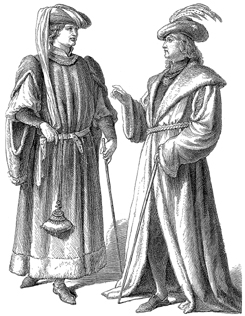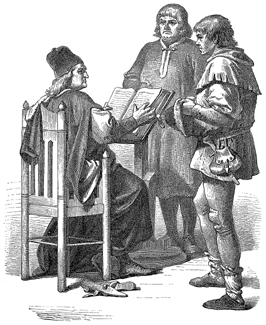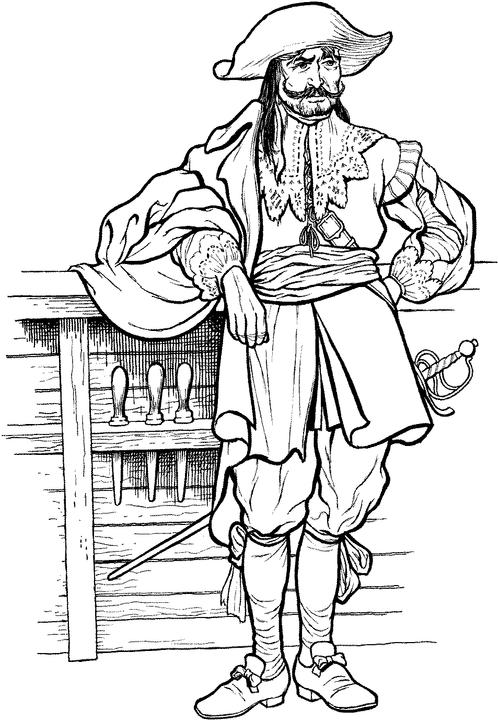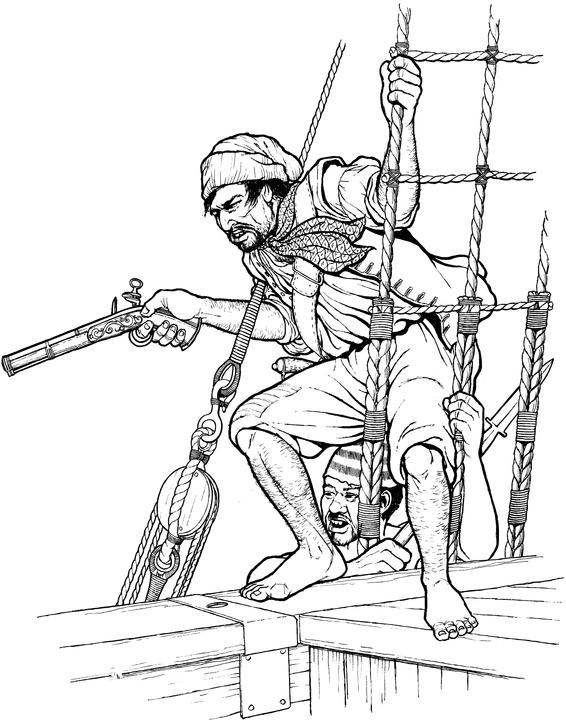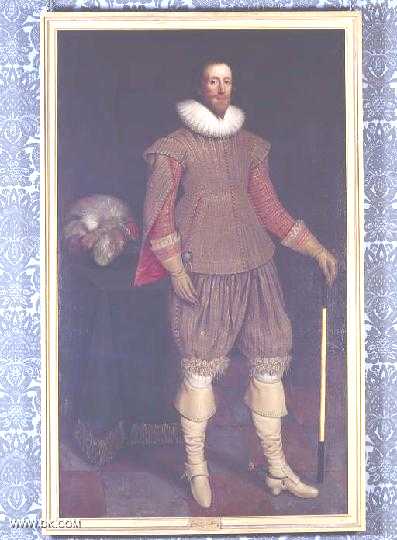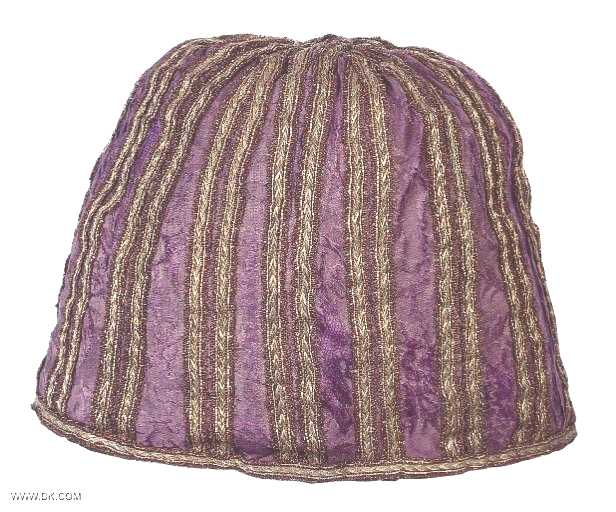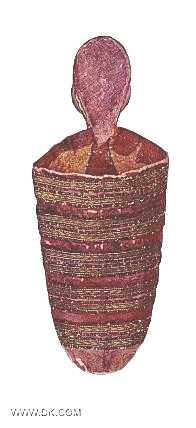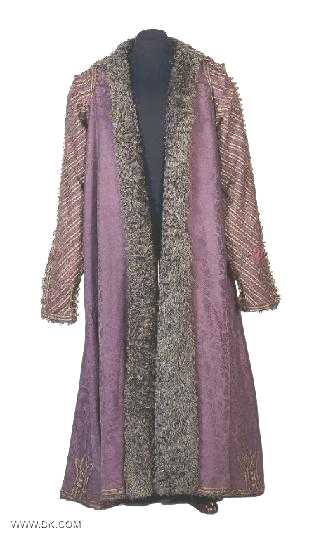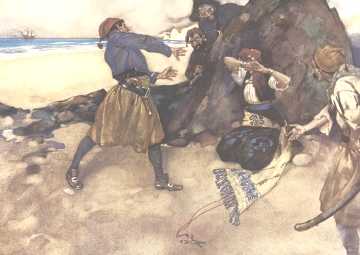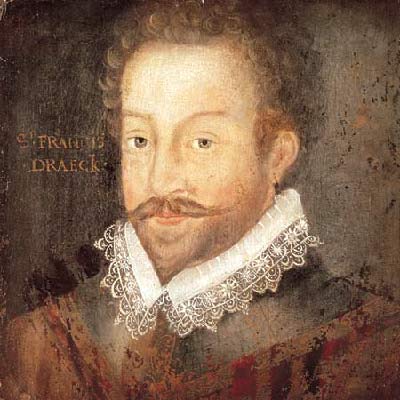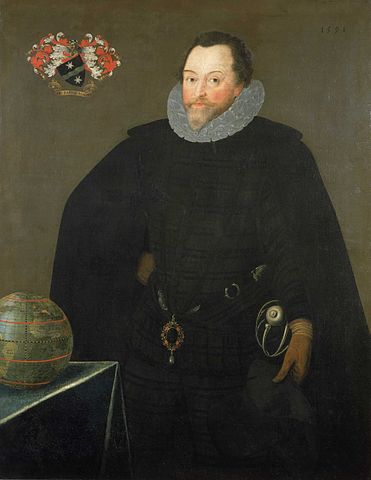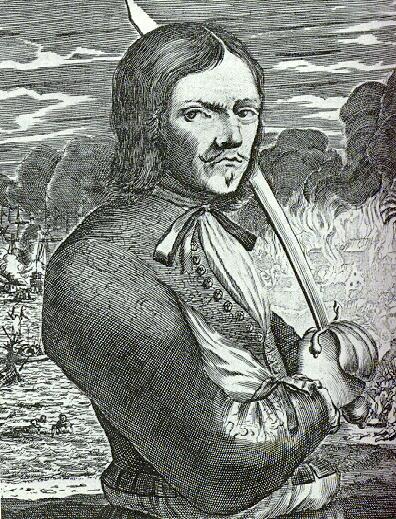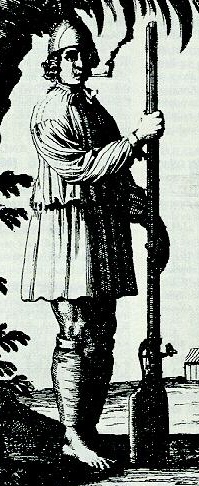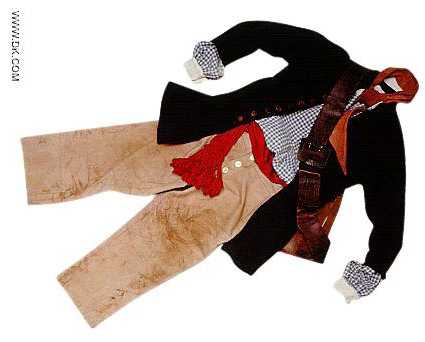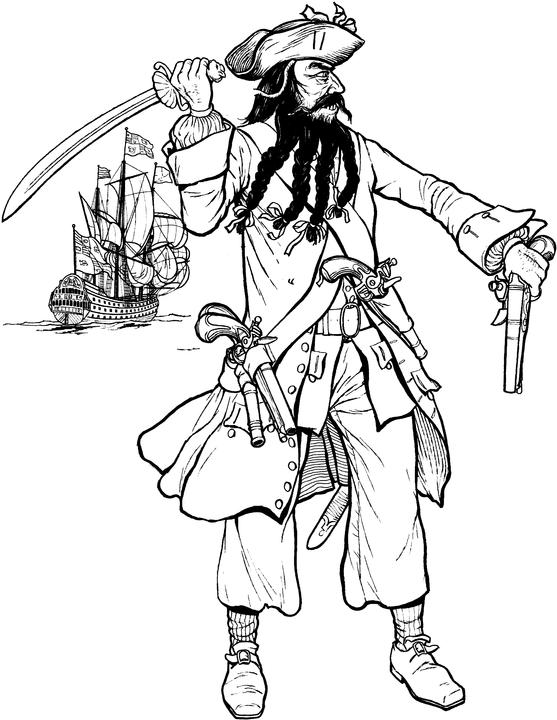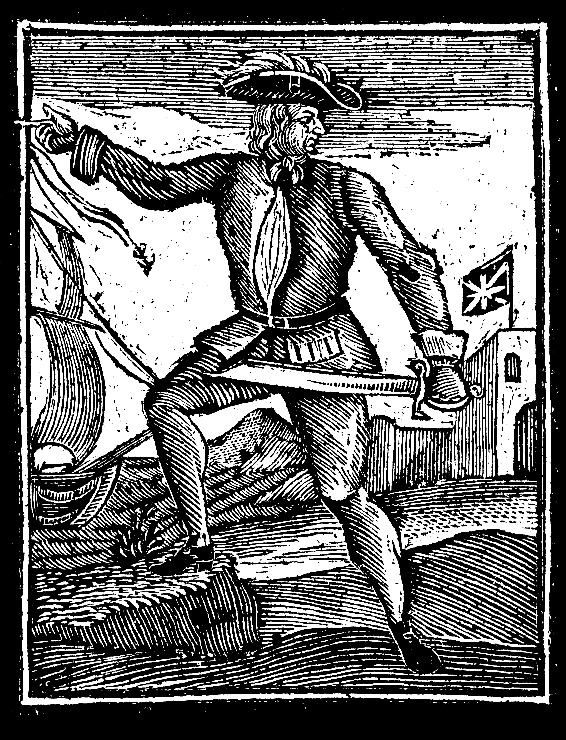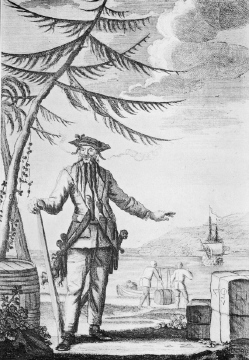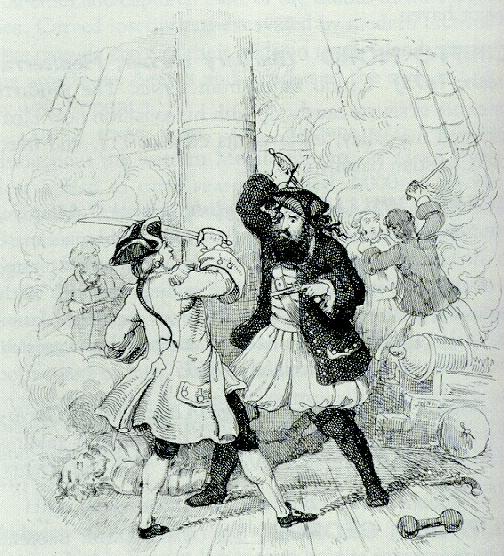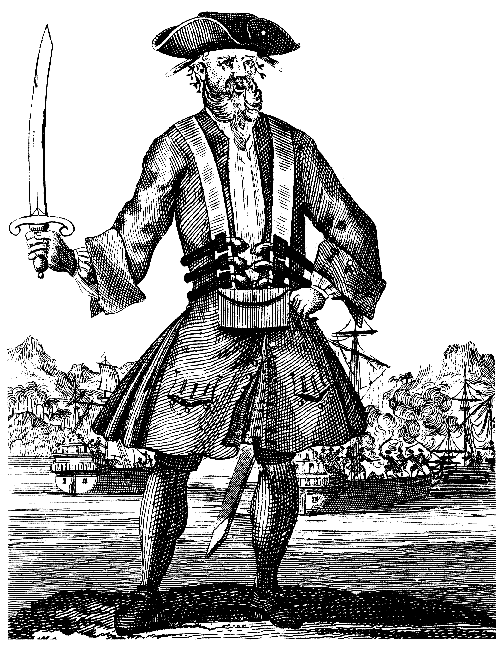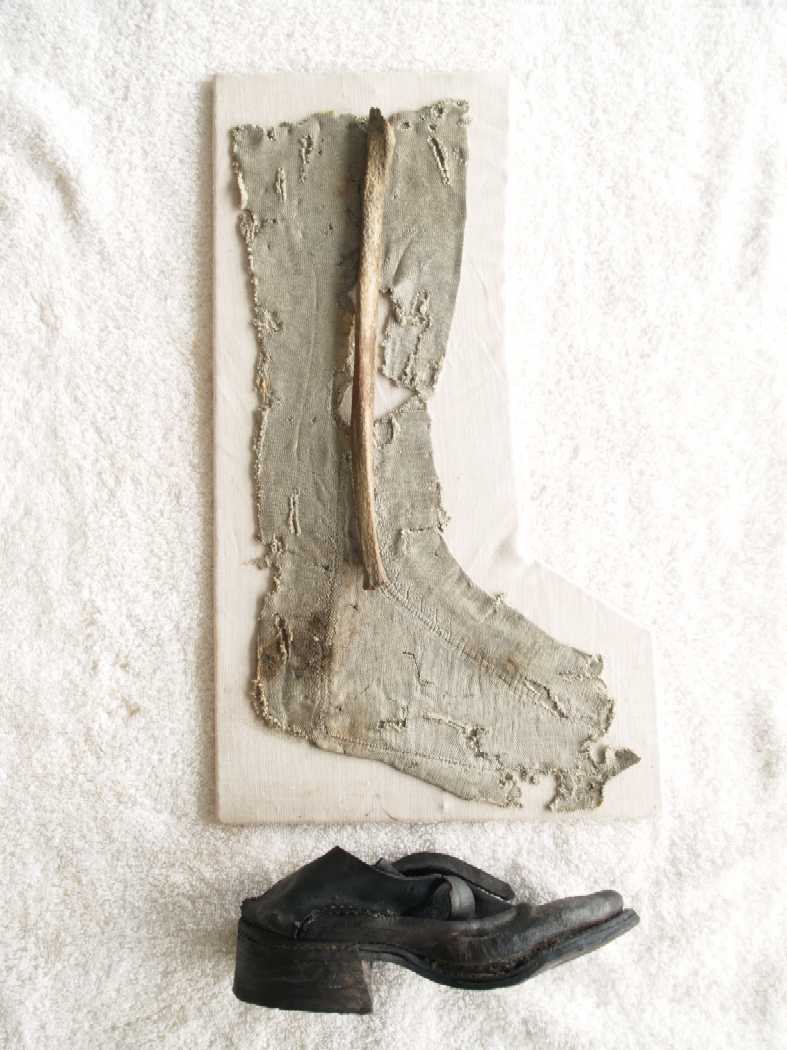The History of Maritime Piracy
Cindy Vallar, Editor & Reviewer
P. O. Box 425, Keller, TX 76244-0425
|
|
|
|
|
|
Pirates and Their Clothes
By Cindy Vallar
In the preface of The Devil’s Cloth is a brief introduction to clothes of the Middle Ages.…everything means something: the fabrics…the pieces and forms, the colors…the work of cutting and assembling, the dimensions, the accessories, and, of course, how the clothes are worn. It is a matter of using conventional and always carefully coded signs to express a certain number of values and to ensure the corresponding verification of them. Everyone must wear the clothes of his state and rank. To dress more lavishly or more shabbily than is customary for the class or the circle to which one belongs is a sin of pride or a mark of debasement. Moreover, it is a transgression against the social order and thus a cause for scandal… (Pastoureau, xi)This was no less true in other historical time periods, and it was true of pirates, who refused to live under the confining rules and regulations of society and government. They often wore the traditional garb of sailors, but acquired articles of clothing outside their station from captured cargo and innocent prisoners. To them the Sumptuary Laws1, first passed in the 1300s in England and France, were meant to be broken.
Dress of French nobles vs. a judge, townsman, and peasant during the 15th century.It is perhaps fitting to begin by citing this particular tome, for it concerns itself with the history of stripes, and stripes have long been associated with mariners. When this association began is a mystery yet to be unraveled, but by the middle of the 1600s, sailors appearing in English and Dutch paintings, wear red and white, or blue and white, horizontally striped shirts. And most were accomplished sewers – a skill learned from mending sails. In December 1708, Bartholomew Roberts set six men to adapting blankets and canvas into clothing suitable for colder climates. Mariners with a particular talent for sewing sometimes decorated their shirts with embroidery.
Sailors, the most numerous aboard the ship, were members of the lowest level in the hierarchy of their wooden world. They heeded the orders, never gave them and rarely defied them, similar to peasants and the gentry above them on land. Clothing was a visual way of distinguishing a person’s station. Barber surgeons, for example, wore coifs of silk that set them apart from others. Wide breeches open at the knee and stripes eventually distinguished mariners from other members of the working class.
Dress of a pirate captain vs. that of one of the crewChaucer provided one of the earliest descriptions of the seafaring outfit when he described the mariner in The Canterbury Tales as being “all in a gowne of falding to the knee.” Some fifteenth-century sources depict sailors clad in hooded gowns with wide sleeves that reached to their elbows. The slitted hems made it easier to work aloft. In 1529 Christophe Weiditz traveled to Spain as a passenger, but he donned the garments of a sailor for the journey. Rather than slops (see note 10), he wore striped trousers and a tunic.
The English warship Mary Rose sank in the summer of 1545. Marine archaeologists have sifted through the wreckage and found more than 655 artifacts that once belonged to the sailors, officers, and passengers at the time. These provide a glimpse of what Tudor men, mariners in particular, wore. The typical male dress of this period comprised a hat, linen shirt, jerkin2, breeches3, hose, and shoes. All of these have been recovered. The most prevalent foot coverings were either slip-on shoes or ankle boots. Some jerkins had buttons for closures; others had holes for lacing, although the laces didn’t survive. Two types of headgear dominate the finds: bonnets, sometimes of silk and velvet or other fine fabric, and woolen caps. The woolen caps4 were round with a flat double brim. They were either coarsely knitted or felted and blocked, and they were fairly waterproof.
Two other mariners of the Tudor period, who were also pirates, were the English Sir Richard Hawkins and the Irish Dubh dara5 O’Malley. The former, one of Queen Elizabeth’s Sea Dogs6, supplied “rugge7 gowns for my people….” (Agnes, Shirts, 36). The latter, father of the legendary Granuail (Grace) O’Malley, wore tight, worsted trews, a saffron shirt with wide sleeves, and a studded jack of tanned leather under a large woolen cloak fringed at the neck and fastened with a gold pin. His feet were clad in square-toed brogues.
Early in the next century, Sir Francis Verney8, a graduate of Oxford, converted to Islam in 1608 and became a renegado9. He wore a richly embroidered purple hat and plush coat, possibly brocade, trimmed in fur. He also wore soft slippers.
Verney's hat & slipper
Verney's coatIn 1623 the English Royal Navy began stocking a “slop chest” aboard its vessels. Merchants also adopted this procedure, which allowed them to supply “necessaries [garments] for the clothing of [sailors]”. Pirates, however, acquired new outfits and finery from their victims. After sea rogues captured Captain Samuel Cary’s ship, the Samuel, on 13 July 1720, the Boston News-letter reported that “[t]he first thing the pirates did was to strip both passengers and seamen of all their money and clothes…with a loaded pistol to every one’s breast ready to shoot him down who did not immediately give an account of both, and resign them up.” (Sanders, 113) The following year, a pirate appropriated all the clothes of John Wingfield, the Royal African Company factor aboard the Hannibal, and for a week paraded in front of the factor in all his purloined finery.
Adam Baldridge, a pirate turned merchant who sold wares to the pirates at Madagascar, received a shipment of clothes on 7 August 1693. The consignment included “44 paire of shoes and pump, six Dozen of worsted and threed stockens, three dozen of speckled shirts and Breaches, twelve hatts…” (Antony, 69)
Although much of the clothing described in this article befit English mariners, the garments Western European sailors wore were basically the same with minor variations. An engraving of a Dutch sailor in 1694 shows him clad in petticoat trousers, a “short jacket with flaring skirts,” and a fur cap. The latter two items were particular to mariners of the Netherlands. Colonial and European seafarers generally wore wide, knee-length trousers10, jacket11 and waistcoat, shirt, kerchief, hat, work gloves, and shoes with buckles. Canvas12 or linen was the preferred fabric for the slops (trousers – see note 10), but sometimes the material was checked or striped. They protected the wearers’ undergarments from the tar and paint sailors came in contact with daily while tending to their work. The collarless jacket was usually single-breasted, blue or gray, and had horn, leather, or metal buttons, but some accounts mentioned buttons of hardened cheese or “ye Joints of ye Back-Bone” of a shark. Waistcoats had no linings and were usually striped. Some buttoned down the front, while others were tied with laces. His kerchief might be black, colored, checked, or spotted. Laced shoes were rare among sailors, and in warmer climates, pirates and merchant seamen often went barefoot while at sea.
Pirate wearing typical seafaring outfit
Hats came in a variety of styles and fabrics. Seafarers since the 1570s favored the Monmouth cap13, which was knitted from brown wool. Sir Francis Drake carried over four hundred of these when he set sail for the West Indies in 1596.14 Knitted caps were less likely to be blown off by the wind than a cocked hat, which was more likely to be worn ashore. Seventeenth-century sailors also wore bonnets. Another type of hat made of felt or tarred canvas was small, round, and black, and, when cocked, gave the sailor the appearance of wearing “a triangular apple pastry” atop his head. (Copeland, 9) Those who opted not to cock their hats sometimes adorned them with ribbon. Leather, fur, and fur-trimmed cloth caps were also worn, as were thrums.15 Pirates who preyed in Caribbean waters sometimes wore scarves or turbans, straw hats, or ones with wide, floppy brims. Some decorated their hats with plumes or jewels.
The work clothes pirates wore wear durable and practical. Not only did seafarers wear their garments while going about their tasks, they also slept in them. Edward Barlow, a mariner of the 1600s, wrote, “…half awake and half asleep, with one shoe on and the other off, not having time to put it on: always sleeping in our clothes for readiness.” (Sanders, 20)
Oftentimes pirates owned a single outfit that they wore until the tattered garments could no longer be repaired. When new recruits went on the account – either willingly or forced – they continued to wear the clothes on their back at the time of their capture, so the crew’s wardrobe might be a mixture of merchant and naval outfits, depending on the type of ship they abandoned. John Eshwell, a carpenter who joined Bartholomew Roberts’ crew, donned his best suit and placed ribbons on his hat before joining the pirates. When sea rogues deigned to wash their clothes, they did so in seawater – fresh water was scarce – and only when warm weather would allow them to dry.
Sailors tarred their outer clothing to protect themselves from the wet weather. They began to do this at least as early as 1631. Artisans, such as carpenters and joiners, also wore leather, canvas, or linen aprons to protect their clothes. Officers, of course, wore finer clothes than what their men wore. This was especially true prior to the eighteenth century, when pirate captains – like Sirs Francis Drake and Henry Morgan – were gentlemen. The men of Drake’s time period wore stiff ruffs, instead of collars, that were usually made of lace. They favored beards16 and mustaches.
Francis Drake, sea captain, vs. Sir Francis DrakeThe portrait of Morgan in one edition of Alexandre Exquemelin’s The Buccaneers of America shows him wearing a slashed doublet and embroidered baldrick. Although he favored a short, pointed beard similar to Drake’s, he also tied a scarlet kerchief around his forehead. When he accepted the surrender of a Spanish nobleman, though, he sometimes donned a wig. If working, Morgan often wore a cotton shirt, breeches, and leather boots. Even when he dressed in the clothes of his trade, he understood the importance of garments to mariners and pirates because they were a scarce commidity. After his flagship Oxford blew up, killing quite a few pirates, he sent boats to collect the bodies, “not out of any design of affording them Christian burial, but only to obtain the spoil of their clothes and other attire.” (Talty, 146) The “other attire” consisted of their gold rings and other valuable jewelry.
L’Olonnais, another and more infamous pirate, wore a short doublet trimmed with squares around his waist. These two buccaneers (Morgan and L’Olonnais) provided quite a contrast from the clothes worn by the original boucaniers: long, rough linen shirts; hide breeches; and round leather caps without brims – all of which were coated with the blood and grease of butchered animals. Some tied their hair in queues, while others wore it loose. Their belts were usually made of cowhide or alligator skin.
Left to Right: Morgan and L'Olonnais, the buccaneers, vs. an original boucanierIn February 1719, Calico Jack Rackham acquired a cargo containing silk stockings and laced hats. He appropriated some of this finery for himself. He earned his nickname because he liked to wear garments of calico, which became popular in the late 1600s and came from India. The female members of his crew, Mary Read and Anne Bonny, donned seafaring garments when they attacked a hapless vessel. Dorothy Thomas, who testified against the women at their trial, said they “wore Mens Jackets, and long Trouzers, and Handkerchiefs tied about their Heads; and that each of them had a Machet and Pistol in their Hands.” (British, vol. 3, 27) Two Frenchmen testified that “when they saw any Vessel, gave Chase or Attacked, [Bonny and Read] wore Men’s Cloaths; and, at other Times, they wore Women’s Cloaths….” (British, vol. 3, 28)
Early pictures portray the two female pirates wearing outfits similar to the one shown above. Sashes of various colors or patterns were popular among pirates. They particularly favored red ones, since the dye used to create this color was expensive, which meant only wealthy men owned such luxuries. Sometimes these were worn under a leather belt, other times as belts themselves.
All seafaring men, be they pirate or not, liked to dress up when they went ashore. They preferred to copy the gentry and would swagger in their finery to impress the women. After pirates captured a ship laden with rich clothing, Père Labat watched their “comical sight as they strutted about the island in feathered hats, wigs, silk stockings, ribbons, and other garments.” (Bandits, 234) A sailor named Samuel Kelly “exchanged my old sea clothes for a fashionable blue coat, ruffled shirt, etc. with my hair dressed and powdered.” (Copeland, 12) In 1716 one victim described what happened when pirates found his wig.
I could not refrain laughing when I saw the fellows, for they had, in rummaging my cabin, met with a leather powder bag and puff, with which they had powdered themselves from head to foot, walked the decks with their hats under their arms, minced their oaths, and affected all the airs of a beau with an awkwardness that would have forced a smile from a cynic. (Sanders, 10-11)Blackbeard, on the other hand, preferred to wear a long beard and hair, rather than don a wig and shave his face. A contemporary historian recorded the villain’s facial hair, which was braided and tied with small ribbons. “This beard was black, which he suffered to grow of an extravagant length. As to breadth, it came up to his eyes.” (Woodard, 161) Prior to confronting his prey, he placed lit fuses under his hat that extended into his beard. This created a ring of smoke and fire around his face.
Edward Teach (also known as Blackbeard) and Howell Davis
In 1720 pirates under the leadership of Howell Davis, Thomas Cocklyn, and Oliver la Bouche captured the Bird, an English vessel captained by William Snelgrave. When the men confiscated the booty, it included bolts of satin, silk, and taffeta; coats; watches; and waistcoats. A passenger, who sailed aboard a vessel seized by Edward Low, submitted an advertisement to the Boston Newsletter, published in the 18-25 June 1722 issue, that listed a variety of garments the pirates took:
…one scarlet suit of Clothes, one new gray Broad Cloth Coat, 1 Sword, with a fine red Velvet Belt…nine Bags of Coat and Jacket Buttons, a considerable quantity of sewing Silk and Mohair, Shoe Buckles…one Scarff of Red Persian Silk, fringed with black Silk…one Beaver Hat bound with Silver Lace… (British, v. 1, 287)Plundered clothing was often auctioned at the mast, and pirates paid for these garments from their share of booty. Those who had boarded the prize, though, were guaranteed a “shift of clothes” from the captured vessel. James Parrot, one of John Quelch’s men, received enough silk “as would make a pair of breeches” as part of his share of the prize. (Beal, 56)Pilfered garments sometimes caused friction among the pirates, particularly when appropriated without going through the normal sharing out process. Snelgrave described one such incident.
Amongst my Adventure of Goods, I had in a Box three second-hand embroidered Coats. One day the three Pirate Captains…enquired for them, saying, “They understood by my Book such Clothes were in my Ship.” I told them, “They were in a Box under the bed place in the State-room. So they ordered them to be taken out, and immediately put them on.” But the longest Coat falling to Cocklyn’s share, who was a very short Man, it almost reached as low as his Ancles. This very much displeased him, and he would fain have changed with Le Boofe, or Davis: But they refused, telling him, “As they were going on Shore amongst the Negroe-Ladies, who did not know the white Mens fashions, it was no matter. Moreover, as his Coat was Scarlet embroidered with Silver, they believed he would have the preference of them, (whose Coats were not so showy) in the opinion of their Mistresses.The Pirate Captains having taken these Cloaths without leave from the Quarter-master, it gave great offence to all the Crew; who alledg’d, “If they suffered such things, the Captains would for the future assume a Power, to take whatever they liked for themselves.” So upon their returning on board next Morning, the Coats were taken from them, and put into the common Chest, to be sold at the Mast. (Antony, 83-84)
Bartholomew Roberts preferred the garments of the wealthy: “silks, satins17 and velvets crowded together, breeches and waistcoats, three-quarter length coats, shirts ruffled and pleated, buckled shoes, fine hose, hats, wigs18, sashes, thinly supple swords, engraved pistols whose loss had cost their previous owners half a year’s income.” (Burl, 146) Captain Johnson described the pirate captain bedecked in “a rich crimson Damask Wastcoat and Breeches, a red Feather in his Hat, a Gold Chain round his Neck, with a Diamond Cross hanging to it.” (Defoe, 243)
The typical ensemble of an early eighteenth- century gentleman included a long, narrow cravat (worn instead of a collar); a knee-length coat – which the French called surtout or justacorps and the English referred to as cassocks – that buttoned down the front and had straight sleeves with their cuffs turned back; a waistcoat slightly shorter than the coat; and knee breeches. Wigs were popular, and some men dusted them with powder, but most kept the natural color. Hats were flat or had their brims cocked up in one, two, or three19 points. Men preferred to wear shoes, rather than boots, and the buckles could be changed from one pair to another because they were expensive. Hose that stretched to the knees were also worn. From the description of garments that Roberts preferred, these would have been the outfit a gentleman wore for work or a casual evening at home. More formal-wear fabrics included gold, silver, brocade, flowered velvet, and embroidered cloth. If his breeches were of the three fabrics quoted above, these would have been evening wear, as opposed to daytime clothing, which would have been made of sturdier material.
Once caught, pirates spent their time in jail without benefit of changes of clothes. The issue of the Boston Gazette for 21-28 March ran a story of pirates as they entered a courtroom in Curaçao.
The Commander went at the Head, with about twenty other Pirates, with their Black Silk Flagg before them…& no care taken in Dressing, they were very offensive, and Stunk as they went along…. (British, v. 1, 322)Other pirates opted to wear their finery into battle. When HMS Swallow’s surgeon boarded Roberts’ Ranger to tend the wounded, he found the villains dressed in “white shirts, watches, and a deal of silk vests.” (Sanders, 216)When it came to their executions, some pirates donned their best clothing. In 1603 Christopher Oloard dressed in “black velvet trousers and jacket, crimson silk socks, black felt hat, brown beard, shirt collar embroidered in black silk.” (Rogozinski, 245) Two years later, a rogue named Clinton20 wore a “velvet doublet with great gold buttons” and “coloured velvet Venetians21 laid with great gold lace,” both of which were “apparel too sumptuous for sea rovers.” (Jowitt, 154) Just over a century later, Dennis McCarthy tied long blue ribbons around his cap, neck, wrists, and knees. Before the hangman’s noose tightened, he kicked off his shoes because “some friends of his had often said he would die in his shoes, but that he would make them liars.” (Woodard, 303) Like McCarthy, Thomas Marris also wore ribbons, but he chose red ones for his final outing.
Other pirates deemed this an excellent time to donate their finest clothes to others. The author of The Annales of England mentioned a pirate named Purser,22 who “rent his Venetian breeches of crimosin taffeta, and distributed the same to such his old acquaintance as stood about him.” (Jowitt, 153)
Being members of one of the earliest professions of man, sailors who traveled the Mediterranean in ancient times often wore no clothes when the weather was fair. Ashore, though, they and their officers wore knee-length tunics with belts. Cilician pirates favored long tunics and togas. Vikings wore trousers, long-sleeve shirts, and belted tunics. If they wore cloaks, brooches pinned them to right shoulders to allow access to their weapons. Some wore helmets, but most went bareheaded. Since many didn’t own shirts of chainmail, they wore padded leather armor. Most pirates who preyed in the waters around Africa and the Indian Ocean may have worn kerchiefs of bright patterns or Arabian headgear. Elsewhere in the world, pirates wore outfits that were more traditional to the countries they came from or the tribes they belonged to. The Dyaks23 sported several brass rings in their ears and wore multi-colored, odd-shaped caps. The Ilanun24 wore sarongs, headcloths, sleeping cloths, and embroidered belts.
Kaizoku pirates of sixteenth-century Japan wore simple armor with family badges on the breast plates, shirts, and trousers. On their feet they sported sandals made from straw. The wako of the 1540s kept their legs and feet bare. They wore white loincloths and loose jackets tied with straps sewn into the seams. The latter were coarsely woven and dyed in simple patterns. Zheng Mao of China described the wako in 1554 as being “bald25 and…wore mottled green and white clothing.” (Turnball, 2007) They also favored droopy mustaches and beards.
For those wishing to emulate piratical dress, there is one cautionary note. Be wary of pictures of pirates, for their style of dress may belong to that of a later fashion period than the one in which they lived. For example, images of Blackbeard from the eighteenth century depict him in different hats. In 1724, he wears a thrum. Two decades later he’s sporting a low cocked hat. By 1780, he wears a tricorne. The length of his coat also varies according to the style of the day in which the picture was drawn, rather than of Blackbeard’s time.
Why is it difficult to know exactly what pirates wore? The contemporary accounts don’t always go into great detail, and finds like John King’s26 stocking and leather shoe with buckle are rare finds in the world of maritime archaeology.
Notes:
1. The French commoner was forbidden to wear silk, velvet, brocade, taffeta, damask, lace, any fabric containing gold or silver thread, mink, sable, and fox. The colors of gold, silver, scarlet, and purple were also banned, as were pearls and other gemstones. Nor were they permitted to wear imported wool. Henry VIII of England forbade anyone below the rank of knight from wearing various garments of velvet or embroidered with silk. He even went so far as to forbid the second sons of knights from wearing certain fabrics or clothes. Penalties for violating these laws included the loss of one’s title or property, or if one of the lower class, one’s life.
2. A jerkin was made of cloth or leather, usually had short sleeves and a close fit. They varied in styles, but often had a long skirt that covered a man’s hips and thighs. The jerkin was worn over the shirt.
3. Breeches sometimes had a codpiece and were tied with laces.
4. Some of the threads that have survived retain the original colors of the dyes used – woad (blue), weld (yellow), and madder (red).
5. The name means “Black Oak” in Gaelic. His anglicized name was Owen.
6. Elizabeth’s Sea Dogs were both pirate and privateer, but since the word “privateer” didn’t come into use until the eighteenth century, they were called pirates.
7. Rugge was a coarse cloth made from wool.
8. After his father died, Verney lost his inheritance through his stepmother’s trickery, forsook England, and eventually landed in Algiers and, as a Barbary corsair, took English prizes. Once captured by a Sicilian ship, he spent two years as a galley slave before a Jesuit priest ransomed him around 1611. Impoverished, Verney died in Messina, Italy at the age of thirty-one.
9. A Christian who converted to Islam, either to plunder Mediterranean ships or to gain his freedom from slavery.
10. These trousers had a variety of names, including slivers, slops, and petticoat trousers. Slops came into use by the 1580s and remained popular into the 1800s.
11. Fearnought jackets, made from wool, came into use during Captain Cook’s voyages between 1772 and 1784, so they would not have been worn by earlier pirates.
12. Canvas clothes were made from old sails and were usually greased and tarred prior to wearing them to make them waterproof.
13. Monmouth caps were so named because they originated in Monmouth, England.
14. During the reign of Elizabeth I, she instituted a rule that made it mandatory that those of the middle class who were older than seven years must wear hats on special and holy days. Those below the rank of knight were prohibited from wearing ones made of velvet.
15. Thrums were made from the discarded ends of the weaver’s warp. The fabric was good for wearing in wet conditions.
16. Beards remained the fashion for men until 1628. That year, Louis XIII of France shaved all his courtiers.
17. Satin was considered a type of silk in this time period.
18. Wigs were another mark of the gentry, for peasants didn’t wear them. By the eighteenth century wigs were commonplace.
19. Most of us refer to the cocked hat with three points as a tricorne, but this was a term that didn’t come into use until the 19th century.
20. Clinton’s real name was Clinton Atkinson. Sometimes he went by the name of Smith.
21. Breeches worn in the second-half of the sixteenth century that were wide at the top and tapered to the knee.
22. Purser’s real name was Thomas Walton.
23. Indigenous to Borneo, the Sea Dyaks were river pirates who terrorized trading vessels and fought other tribes. They collected the heads of dead enemies.
24. William Dampier stayed with the Ilanun when he circumnavigated the world and found them peaceful, but during the 1800s, they were the most feared pirates of Southeast Asian waters.
25. In this case, bald meant they shaved the front of their heads and tied what remained of their hair in pigtails that hung down their backs.
26. John King was the youngest member of Bellamy’s crew. He joined the pirates in November 1716 after they captured the ship he and his mother sailed on. Commander Savage of the Bonetta said, “[John] declared he would kill himself if he was restrained, and even threatened his mother.” (Clifford, 133) The Whydah sank in April 1717 off the coast of Cape Cod during a nor’easter. About 146 pirates, including King, died.
Some of the pictures used in this article come from the DK.com CD that accompanies the 2007 edition of Richard Platt’s Pirate. Others come from Pirates and Braun & Schneider’s Historic Costume, Dover Electronic Clip Art publications. The picture of John King's stocking and shoe are used with permission of Expedition Whydah.
For more information on clothing and dress, I recommend these resources:
Agnes the Red. “How to Cover Yer Shanks,” No Quarter Given 2:6 (November 1995), 16.
Agnes the Red. “Pirate Treasure to Wear or Buy,” No Quarter Given 1:5 (September 1994), 16.
Agnes the Red. “Shirts to Cover that Treasure Chest,” The Pyrate Primer (September 1997), 36. Also found in No Quarter Given 2:3 (May 1995), 16.
Agnes the Red. “The Look of a Rogue,” The Pyrate Primer (September 1997), 39. Also found in No Quarter Given 1:3 (May 1994), 12.
Agnes the Red. “Topping Off Your Pirate Look,” The Pyrate Primer (September 1997), 34.
Agnes the Red. “What the Common Sailor Wore,” The Pyrate Primer (September 1997), 30. Also found in No Quarter Given 1:1 (January 1994), 12 and 2:1 (March 1994), 12.
Antony, Robert. Pirates in the Age of Sail. W. W. Norton, 2007.Bandits at Sea edited by C. R. Pennell. New York University, 2001.
Baumgarten, Linda. “Colonial Dress Codes,” Colonial Williamsburg Journal (Winter 2003-2004).
Beal, Clifford. Quelch’s Gold: Piracy, Greed and Betrayal in Colonial New England. Praeger, 2007.
Before the Mast: Life and Death Aboard the Mary Rose edited by Julie Gardiner (vol. 4 of The Archaeology of the Mary Rose series). The Mary Rose Trust, 2005.
Bold in Her Breeches: Women Pirates Across the Ages edited by Jo Stanley. HarperCollins, 1995.
“Brass Buttons and Trousers,” Beyond the Map. [http://www.beyondthemap.ca/english/daily_brass.html -- link no longer active 7/19/2015]
British Piracy in the Golden Age edited by Joel H. Baer. London: Pickering & Chatto, 2007.
Burl, Aubrey. Black Barty: The Real Pirate of the Caribbean. Sutton, 2006.Cargill-Kipar, Nicole. Late 17th-Century Clothing History.
Chambers, Anne. Granuaile: Ireland’s Pirate Queen c. 1530-1603. Wolfhound Press, 2003.
Clifford, Barry, and Kenneth J. Kinkor. Real Pirates: The Untold Story of the Whydah from Slave Ship to Pirate Ship. National Geographic, 2007.
“Clothing during the Golden Age of Piracy,” Gentlemen of Fortune.
Copeland, Peter F. Working Dress in Colonial and Revolutionary America. Greenwood Press, 1977.de Marly, Diana. Working Dress: A History of Occupational Clothing. Holmes & Meier, 1986.
Defoe, Daniel. A General History of the Pyrates edited by Manuel Schonhorn. Dover, 1999.
Dotson, Leslie. “Treasure of Many Colors: The Calico Trade in the 1700’s,” Pirates Magazine (Spring 2007), 29-33.Foxe, Ed. “Pirate Clothing,” Pirate Mythtory. [http://www.bonaventure.org.uk/ed/clothing.htm -- link no longer active 7/19/2015]
“Getting Started with a Basic Kit,” Gentlemen of Fortune.
Jowitt, Claire. “Scaffold Performances: The Politics of Pirate Execution,” in Pirates? The Politics of Plunder, 1550-1650 edited by Claire Jowitt. Palgrave Macmillan, 2007, 151-168 and 218-219.
Juneaux, Duchess of Netherwaullop. “Breeches for the Seaworthy,” Renaissance Magazine 43, 32-35.Karg, Barb, and Arjean Spaite. The Everything Pirates Book. Adams Media, 2007.
Lehman, Keith. “Time Capsule: Golden Age of Piracy,” Lighthouse Patriot Journal (29 September 2007). [http://lighthousepatriotjournal.wordpress.com/2007/09/29/time-capsule-golden-age-of-piracy-part-i/ -- link no longer active 7/19/2015]
Little, Benerson. The Buccaneer’s Realm. Potomac Books, 2007.
McClellan, Elisabeth. Historic Dress in America 1607-1870. Arno Press, 1977.
McGann, Kass. “Thoughts over the Weekend,” Reconstructing History (30 July 2007).
Pastoureau, Michel. The Devil’s Cloth: A History of Stripes translated by Jody Gladding. Washington Square Press, 2001.
Payne, Blanche. History of Costume: From the Ancient Egyptians to the Twentieth Century. Harper & Row, 1965.
Pirate Clothing
Pirates: Terror on the High Seas from the Caribbean to the South China Sea. Turner Publishing, 1996.
Platt, Richard. Pirate. DK Publishing, 2007.Redicker, Marcus. Between the Devil and the Deep Blue Sea: Merchant Seamen, Pirates, and the Anglo-American Maritime World, 1700-1750. Cambridge, 1999.
Rogozinski, Jan. Pirates! Brigands, Buccaneers, and Privateers in Fact, Fiction, and Legend. Facts on File, 1995.
Rutherford-Moore, Richard. “Pirate Costume: A Short Introduction & Reference,” Sea Thieves.Sackrison, Michael “The Tailor.” “So You Want to Be Authentic: Observations from Forty Years of Tailoring Authentic Items,” No Quarter Given VIII:4 (July 2001), 14-16.
Sanders, Richard. If a Pirate I Must Be…: The True Story of “Black Bart,” King of the Caribbean Pirates. Skyhorse, 2007.
Selinger, Gail. The Complete Idiot’s Guide to Pirates. Alpha, 2006.
Stines, Peter. “The Sharply Dressed Pirate,” The Laffite Society Chronicles XIII:2 (October 2007), 7-9Talty, Stephan. Empire of Blue Water. Crown, 2007.
Telfer, Geordie. Real Canadian Pirates. Folklore Publishing, 2007.
Tortora, Phyllis G., and Keith Eubank. Survey of Historic Costume: A History of Western Dress (2nd edition). Fairchild Publications, 1995.
Turnball, Stephen. Pirate of the Far East 811-1639. Osprey, 2007.Wentworth, Ross. “Seadog Costumes,” Ye Olde Book o’ Seadogs. [http://bookoseadogs.org/?subject=clothes -- link no longer active -- 7/19/2015]
Wilcox, R. Turner. Five Centuries of American Costume. Charles Scribner’s Sons, 1963.
William, Captain. “Pirates Clothes,” The Pirate’s Life. [http://www.pirates-life.com/clothes.html -- link no longer active -- 7/19/2015]
Woodard, Colin. The Republic of Pirates. Harcourt, 2007.X Marks the Spot: The Archaeology of Piracy edited by Russell K. Skowronek and Charles R. Ewen. University Press of Florida, 2006.
Copyright © 2008 Cindy Vallar
Home Pirate Articles Pirate Links Book Reviews Thistles & Pirates
